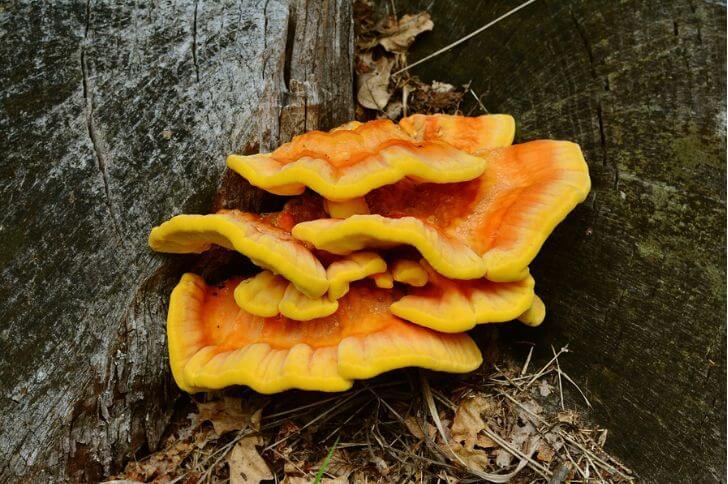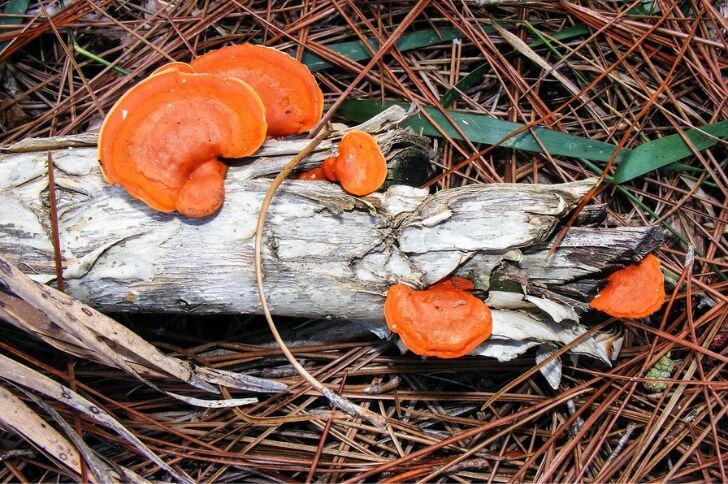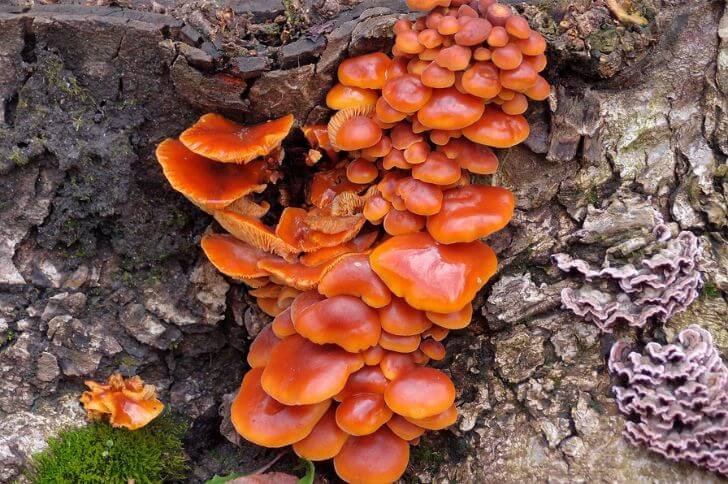In the enchanting world of fungi, orange mushrooms that grow on trees stand out as vibrant and mysterious inhabitants of the forest.
Their unique appearance and ecological significance have captivated the curiosity of scientists, nature enthusiasts, and foragers alike.
These fascinating organisms are not only visually striking but also play a crucial role in the delicate balance of woodland ecosystems.
From their vivid hues to their intricate growth patterns, exploring the diverse types of orange mushrooms that thrive on tree trunks is a journey into a realm where science meets wonder.
List of Orange Mushrooms that Grow on Trees
1. Chicken of the woods

Chicken of the woods, scientifically known as Laetiporus sulphureus, is a strikingly vibrant orange mushroom that grows on decaying trees.
Its unique appearance and delicious taste make it a sought-after find for foragers and culinary enthusiasts alike.
Often resembling a cluster of overlapping shelves, this mushroom’s flamboyant coloration stands out against the backdrop of forest greenery and can be quite the sight to behold.
One interesting aspect of chicken of the woods is its versatility in cooking. With a texture similar to that of chicken breast, this fungus is commonly used as a meat substitute in vegetarian and vegan dishes.
It absorbs flavors well and has been likened to poultry in both taste and consistency when cooked properly, making it an enticing option for those seeking plant-based alternatives. Additionally, its high protein content and low caloric value make it an appealing choice for those conscious about their dietary intake without wanting to compromise on flavor or texture.
2. Cinnabar polypore

The Cinnabar polypore is a striking sight in the forest, its vibrant orange hue standing out against the subdued tones of tree trunks and undergrowth.
Growing primarily on dead or dying coniferous trees, this distinctive mushroom boasts a velvety texture and a fan-like shape that adds to its allure. But beyond its visual appeal, the Cinnabar polypore holds unexpected secrets.
As a decomposer, it plays a crucial part in breaking down wood and recycling nutrients back into the soil.
This not only benefits other plant life but also contributes to the overall balance and sustainability of woodland environments. Moreover, recent studies have shed light on how this mushroom interacts with other organisms such as insects and bacteria, unveiling intricate connections that underscore the complexity of nature’s web.
3. Flammulina Velutipes

Flammulina velutipes or velvet shanks are fascinating orange mushrooms that grow on trees. This unique fungus has a striking appearance with its orange cap and slender stem, making it an intriguing specimen for mushroom enthusiasts and nature lovers alike.
What sets velvet shanks apart from other mushrooms is its ability to thrive in cold conditions, often sprouting during the winter months when many other mushrooms are dormant. This resilience and adaptability make it a remarkable organism worthy of study and admiration.
In addition to its eye-catching color and seasonal growth pattern, these orange mushrooms that grow on trees also boast impressive nutritional benefits.
Rich in protein, fiber, vitamins, and minerals, these mushrooms offer a wholesome addition to any diet. Furthermore, their distinct texture and delicate flavor make them a popular choice in various cuisines around the world.
Whether enjoyed raw in salads or cooked in soups and stir-fries, these mushrooms that grow in tight clusters provide both culinary delight and nutritional value.
4. Russula Nobilis (Beech sickener)
The beech sickener (scientific name; Russula nobilis) is a captivating sight in the forest with its convex to flat rosy red to orange cap and ivory white gills.
Another way to identify the russula nobilis is by its white, slightly thick, stem with no ring. It has a white spore print.
They commonly grow under beech trees and are widely spread in North America and Europe. What makes this particular orange fungus unique is its ectomycorrhizal relationship with beech, forming a symbiotic bond that benefits both parties.
This mutualistic connection allows the Russula nobilis to access nutrients from the tree while simultaneously providing it with essential minerals.
Despite its striking appearance, the beech sickener is not edible.
5. Omphalotus olivascens (Western jack-o’-lantern mushroom)
Omphalotus olivascens, or the western Jack O’Lantern mushroom, is a visually striking species that often elicits curiosity and wonder. Found predominantly in Mexico and California, these vibrant orange mushrooms can be spotted growing on tree trunks and decaying wood from July to October.
What sets this species apart is its bioluminescent properties, which means it emits an eerie greenish glow in the dark—creating an almost otherworldly ambiance in the forest.
One particularly intriguing aspect of jack-o’-lantern is its toxic nature. Unlike their edible look-alikes, such as chanterelles mushrooms, these orange mushrooms are inedible.
6. Fomitopsis pinicola (Red-belted conk)
Fomitopsis pinicola, commonly called red-belted conk or red pore fungus, is a captivating species of red-orange mushroom that often finds its home on the trunks of conifers (sometimes birches).
Its a perennial fungus common in temperate Europe. Its vibrant color (when young) and distinctive shelf-like appearance make it a striking sight in forested landscapes.
Young red-belted conks are reddish-orange on the surface and white underneath. Like other shelf mushrooms, this orange mushroom has pores underneath.
But beyond its aesthetic appeal, this unique fungus plays an important ecological role as a decomposer, breaking down dead wood and returning nutrients to the forest floor.
Are red belted-conks edible? Due to their tough nature, they are inedible. They have a whitish-yellowish spore print.
7. Orange Mycena
The Orange mycena, also known as Mycena leaiana, is a striking species of orange mushroom that grows in tight clusters. Found predominantly in North America, New Zealand and Australia, these vibrant orange mushrooms can be spotted growing on decaying logs and tree branches.
Their distinctive coloration adds a pop of brightness to the forest floor or woodland areas, making them particularly captivating to those who come across them.
How can you identify these orange mushrooms on trees? Orange mycenas grow in clusters, picture tens of small mushrooms together.
Another way you can identify their fruiting body is by looking at their size. These mycenas have small orange bodies with bell-shaped caps and long thin stems.
Underneath you’ll note widely spaced gills that produce a white spore print. Like most orange mushrooms, these orange mycenas are inedible.
8. Dyer’s Polypore
Commonly called the velvet top-fungus or dyer’s polypore, scientific name;Phaeolus schweinitzii, this large mushroom is mostly found on dead or living conifers.
Unlike other fungi that grow on trees, this bracket fungus is dull orange to yellowish. Because of common look-alikes, it’s important you learn how to identify them.
The dyer’s polypore has a large fruiting body, about 11 inches wide. The body consists of lobed caps that form a rosette like structure.
Underneath, pores are orangish-yellow in young fungi, changing to rusty brown in age.
What sets Dyer’s polypore apart is its historical use in dyeing textiles, where it was utilized for its earthy yellow hues. This unique characteristic has sparked renewed interest in this humble mushroom from artisans and natural dye enthusiasts seeking sustainable alternatives to synthetic dyes.
9. Witch’s Butter
Considered a mysterious and intriguing fungus, Witch’s Butter, also known as Tremella mesenterica, is a sight to behold.
Its vibrant orange color stands out against the bark of trees, drawing attention from curious nature enthusiasts. This jelly-like mushroom grows in gelatinous blobs that can vary in size and shape, adding an otherworldly aesthetic to the forest landscape.
Despite its unassuming appearance, Witch’s Butter has been used for centuries in traditional Chinese cuisine. Its unique texture and bright hue have also earned it a place in culinary explorations, where it adds a pop of color and delicate texture to various dishes.
The symbiotic relationship between this peculiar fungus and the trees on which it thrives offers a fascinating glimpse into the interconnectedness of ecosystems, providing ample food for thought for those captivated by the wonders of nature.
Final Thoughts
The diversity of orange mushrooms that grow on trees is truly fascinating. From the conspicuous and vibrant colors of the chicken-of-the-woods to the delicate beauty of the orange mycena, each type holds its own unique characteristics and ecological importance.
Understanding these different species can not only enrich our appreciation for nature but also deepen our understanding of forest ecosystems.
sources:

